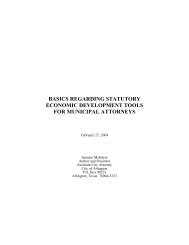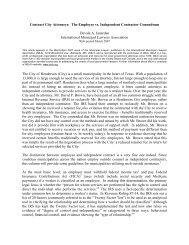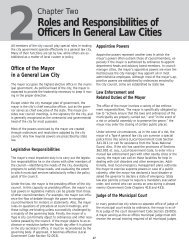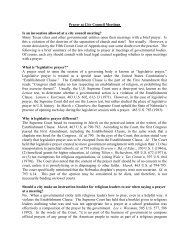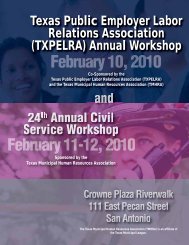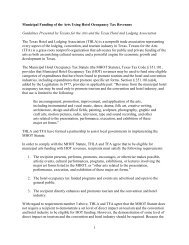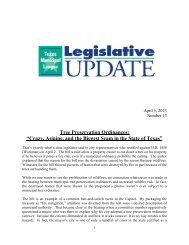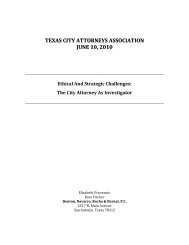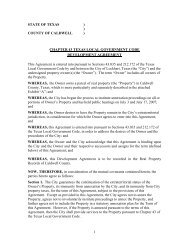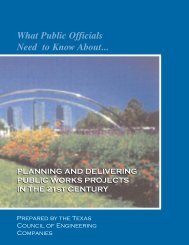Local Government in Texas - Texas Municipal League
Local Government in Texas - Texas Municipal League
Local Government in Texas - Texas Municipal League
You also want an ePaper? Increase the reach of your titles
YUMPU automatically turns print PDFs into web optimized ePapers that Google loves.
Chapter One1<strong>Local</strong> <strong>Government</strong> <strong>in</strong> <strong>Texas</strong>Understand<strong>in</strong>g city government requires some knowledge ofall local governments. This chapter briefly discusses counties,school districts, council of governments, and types ofcity governments.Units of <strong>Local</strong> <strong>Government</strong>COGs are voluntary, area-wide associations of local governments.Their function is to foster local cooperation amonglocalities by serv<strong>in</strong>g as forums for <strong>in</strong>tergovernmental problem-solv<strong>in</strong>gand by plann<strong>in</strong>g governmental programs and facilitieson a regional basis. Though they do not have broadpower to execute projects, many of the state’s COGs providedirect services on a limited basis.Accord<strong>in</strong>g to 2002 Census of <strong>Government</strong> figures, <strong>Texas</strong> has1,196 cities, 254 counties, 1,089 school districts, and2,245 special districts. Dur<strong>in</strong>g the past 20 years, the numberof special districts has steadily <strong>in</strong>creased, due ma<strong>in</strong>ly tothe rapid creation of water districts <strong>in</strong> un<strong>in</strong>corporated areas.Conversely, the number of school districts has steadily decl<strong>in</strong>ed,as smaller systems have consolidated with largerones. The number of counties has rema<strong>in</strong>ed constant for100 years, while the number of cities is <strong>in</strong>creas<strong>in</strong>g at an averageof about 10 per year.CountiesCounties are known as “general purpose” governments dueto the many different functions they perform. Counties servethe dual purposes of provid<strong>in</strong>g governmental services for thebenefit of their residents and adm<strong>in</strong>istrative services on behalfof the state. Major governmental services <strong>in</strong>clude roadconstruction and ma<strong>in</strong>tenance, jails and courts, welfare,health, and law enforcement. Adm<strong>in</strong>istrative services performedby counties as agents of the state <strong>in</strong>clude voter registrationand motor vehicle licens<strong>in</strong>g.Special DistrictsSchools and the many types of special districts are knownas “s<strong>in</strong>gle-purpose” governments, s<strong>in</strong>ce they usually performjust one function, such as education, water supply, orhospital care. Most special districts serve a limited geographicalarea and were created because of the <strong>in</strong>ability ofgeneral purpose local governments to provide a particularservice.Councils of <strong>Government</strong>sCouncils of governments (COGs) are also known as “regionalplann<strong>in</strong>g commissions.” COGs are def<strong>in</strong>ed as “political subdivisionsof the state” under <strong>Texas</strong> law. However, COGs differconsiderably from cities, counties, and other conventionallocal governments because they cannot levy taxes nor <strong>in</strong>curdebt.Each COG operates under the supervision of a govern<strong>in</strong>gbody composed of elected officials represent<strong>in</strong>g participat<strong>in</strong>glocal governments. F<strong>in</strong>anc<strong>in</strong>g is provided by a comb<strong>in</strong>ationof dues paid by member governments and federal andstate funds.CitiesAmong all of the different types of local governments, citiesperform the greatest number of functions, both governmentaland proprietary.State law specifically def<strong>in</strong>es and lists certa<strong>in</strong> activities aseither governmental or proprietary. The law lists 36 functionsthat are governmental. Included among them are policeand fire protection, health and sanitation services,street construction and design, transportation systems, establishmentand ma<strong>in</strong>tenance of jails, and enforcement ofland use restrictions under Chapter 229 of the <strong>Local</strong> <strong>Government</strong>Code. Three functions are listed as proprietary: theoperation and ma<strong>in</strong>tenance of a public utility, amusementsowned and operated by a city, and any activity that is abnormallydangerous or ultra-hazardous. Functions that arelisted as governmental are not <strong>in</strong>cluded as proprietary functions.There are two categories of cities <strong>in</strong> <strong>Texas</strong>: home rule andgeneral law.Home rule cities are larger cities. Any city over 5,000 <strong>in</strong>habitants<strong>in</strong> which the citizens have adopted a home rulecharter is a home rule city. A charter is a document that establishesthe city’s governmental structure and provides forthe distribution of powers and duties among the variousbranches of government.The legal position of home rule cities is the reverse of generallaw cities. Rather than look<strong>in</strong>g to state law to determ<strong>in</strong>ewhat they may do, as general law cities must, home rulecities look to the state constitution and state statutes to determ<strong>in</strong>ewhat they may not do. Thus, if a proposed homerule city action has not been prohibited or pre-empted bythe state, the city generally can proceed.9
General law cities are smaller cities, most of which are lessthan 5,000 <strong>in</strong> population. All general law cities operate accord<strong>in</strong>gto specific state statutes prescrib<strong>in</strong>g their powersand duties. General law cities are limited to do<strong>in</strong>g what thestate authorizes or permits them to do. If state law does notgrant general law cities the express or implied power to <strong>in</strong>itiatea particular action, none may be taken.Approximately seventy-five percent of all <strong>Texas</strong> cities operateunder the general laws; the rema<strong>in</strong>der are home rulecities. “General law” is a term used to describe all of thestate laws applicable to a particular class of th<strong>in</strong>gs. A generallaw city, therefore, is one that is subject to all of thestate laws applicable to such cities, most of which are found<strong>in</strong> the <strong>Local</strong> <strong>Government</strong> Code.General law city officials occasionally call the <strong>Texas</strong> <strong>Municipal</strong><strong>League</strong> office to request a copy of their “city charters.’’Unlike home rule cities, general law cities do not have charters.The creation of a general law city is documented <strong>in</strong> its<strong>in</strong>corporation papers, filed at the county courthouse, whichdescribe when the city was established and its orig<strong>in</strong>alboundaries.Categories ofGeneral Law CitiesThere are three categories of general law cities: Type A, TypeB, and Type C. Although it is sometimes difficult to dist<strong>in</strong>guishbetween the types, it is necessary to know the difference<strong>in</strong> order to determ<strong>in</strong>e which state laws apply.Type B General Law <strong>Municipal</strong>itiesMost new cities beg<strong>in</strong> as Type B general law cities under astate law that permits the <strong>in</strong>corporation of any area conta<strong>in</strong><strong>in</strong>g201 to 10,000 <strong>in</strong>habitants. Later, as the population of acity grows to 600 or more, it can make a transition to Type A.General law cities operate under one of two forms of government:aldermanic or commission.In a Type B general law municipality with the aldermanicform of government, the govern<strong>in</strong>g body is known as the“board of aldermen’’ and <strong>in</strong>cludes six members (a mayorand five aldermen), all of whom are elected at-large. At itsdiscretion, the board of aldermen may provide by ord<strong>in</strong>ancefor the appo<strong>in</strong>tment or election of such additional officersas are needed to conduct the bus<strong>in</strong>ess of the municipality.Any municipality operat<strong>in</strong>g under the commission form ofgovernment can change over to the aldermanic form of government,and vice versa.10Type A General Law <strong>Municipal</strong>itiesType A general law municipalities are the larger general lawmunicipalities. Most were <strong>in</strong>corporated under Type B statusand then switched to Type A status when their population<strong>in</strong>creased to 600 or more, or when they had at least onemanufactur<strong>in</strong>g establishment.Type A general law municipalities operate under one of twoplans of government: aldermanic or commission. A municipalitywith the aldermanic form of government operates <strong>in</strong>accordance with statutes applicable to Type A general lawmunicipalities.The govern<strong>in</strong>g body of a municipality operat<strong>in</strong>g as a Type Ageneral law municipality is known as the “city council” andvaries <strong>in</strong> size depend<strong>in</strong>g on whether the municipality hasbeen divided <strong>in</strong>to wards. If the municipality has been divided<strong>in</strong>to wards, the council consists of a mayor and twocouncilmembers from each ward—whatever the number. Ifthe municipality has not been divided <strong>in</strong>to wards, the govern<strong>in</strong>gbody always consists of a mayor and five councilmembers.In addition to the city council, other municipal officers <strong>in</strong>cludea treasurer, tax assessor-collector, city secretary, cityattorney, and eng<strong>in</strong>eer. Whether these offices are elective orappo<strong>in</strong>tive depends on the method selected by the citycouncil for fill<strong>in</strong>g them. Moreover, the city council may provideby ord<strong>in</strong>ance for the appo<strong>in</strong>tment or election of suchother officers as it deems necessary.Type C General Law <strong>Municipal</strong>itiesA municipality with the commission form of government operatesunder the statutes applicable to a Type C general lawmunicipality. The govern<strong>in</strong>g body is known as the “board ofcommissioners” and always consists of a mayor and twocommissioners. No other elective officers are required; however,the board of commissioners must appo<strong>in</strong>t a city clerk,and may provide by ord<strong>in</strong>ance for the election or appo<strong>in</strong>tmentof such other officers as are required.In a municipality of 500 or less population, the board ofcommissioners must follow the requirements applicable to aType B general law municipality—that is, the board of commissionershas the same powers and duties as the board ofaldermen <strong>in</strong> a Type B general law municipality, except wherespecifically provided otherwise. In a municipality over 500population, the board of commissioners must follow the requirementsof a Type A general law municipality, exceptwhere specifically provided otherwise.Any municipality operat<strong>in</strong>g under the commission form ofgovernment can change over to the aldermanic form of government,and vice versa. The commission form of government<strong>in</strong> a general law city should not be confused with the
Legislation passed <strong>in</strong> 2003 clarifies that city councils ofcities that have not adopted a city manager plan underChapter 25 of the <strong>Local</strong> <strong>Government</strong> Code are free to delegatemanagement duties to a city adm<strong>in</strong>istrator.The Home Rule ConceptAlthough scholars have used a variety of flowery phrases todescribe the concept of home rule, the pr<strong>in</strong>ciple is simple:home rule is the right of citizens at the grassroots level tomanage their own affairs with m<strong>in</strong>imum <strong>in</strong>terference fromthe state. Home rule assumes that governmental problemsshould be solved at the lowest possible level, closest to thepeople.As mentioned earlier, home rule cities look to the state totell them what they are prohibited from do<strong>in</strong>g, rather thanfor specific grants of authority to undertake particular functions.In Forwood v. City of Taylor, the <strong>Texas</strong> Supreme Courtsummarized <strong>Texas</strong>’ home rule doctr<strong>in</strong>e as follows:It was the purpose of the Home-Rule Amendment ... to bestowupon accept<strong>in</strong>g cities and towns of more than 5,000<strong>in</strong>habitants full power of self-government, that is, full authorityto do anyth<strong>in</strong>g the legislature could theretofore haveauthorized them to do. The result is that now it is necessaryto look to the acts of the legislature not for grants of powerto such cities but only for limitations on their powers.As a result of the Forwood case and other court decisionsuphold<strong>in</strong>g their broad powers, home rule cities have the <strong>in</strong>herentauthority to do just about anyth<strong>in</strong>g that qualifies as a“public purpose” and is not contrary to the constitution orlaws of the state.Inherent Powers ofHome Rule CitiesAn “<strong>in</strong>herent power” is one that is possessed by a city withoutits hav<strong>in</strong>g been specifically granted by the state. It isthe right to perform an act without hav<strong>in</strong>g received that rightfrom the <strong>Texas</strong> Constitution or the state legislature.Home rule cities have many <strong>in</strong>herent powers. A discussionof some of the <strong>in</strong>herent powers of major significance mayexpla<strong>in</strong> why so many cities have chosen to adopt home rulecharters.<strong>Municipal</strong> OrganizationIn contrast to counties or general law cities, whose organizationis fixed by state law, the governmental structure of ahome rule city is left entirely to the discretion of local voters.Subject to compliance with the federal Vot<strong>in</strong>g RightsAct, the citizens of a home rule city are free to decide theirform of municipal government (mayor-council, council-manager,and so on); choose between a large or small city council;provide for the election of the city council at-large, bys<strong>in</strong>gle-member district, or by place; fix the terms of officefor councilmembers at two, three, or four years; or establishoverlapp<strong>in</strong>g terms of office. Moreover, they can decidewhether the mayor is to be elected directly by the voters, selectedfrom among members of the council, or chosen bysome other method.The citizens of a home rule city also have total discretionover the city’s adm<strong>in</strong>istrative structure. Subject only to localpreferences, the charter can establish a simple adm<strong>in</strong>istrativeframework or a complex one, provide for the appo<strong>in</strong>tmentor election of major adm<strong>in</strong>istrative officials, and so on.And f<strong>in</strong>ally, the charter can provide for the creation of anyboards or commissions that local voters decide are necessaryto make the city function effectively.AnnexationThe <strong>in</strong>herent power to unilaterally annex adjo<strong>in</strong><strong>in</strong>g areas isone of the most important home rule prerogatives. To annex“unilaterally” means that the city can br<strong>in</strong>g an adjacent, un<strong>in</strong>corporatedarea <strong>in</strong>to the city without the permission of thepersons resid<strong>in</strong>g <strong>in</strong> that area.There is no state law prohibit<strong>in</strong>g home rule cities from annex<strong>in</strong>gadjo<strong>in</strong><strong>in</strong>g territories; therefore, annexation can be exercisedas an <strong>in</strong>herent home rule power, provided statutoryrequirements are fulfilled.The follow<strong>in</strong>g excerpt is typical of a charter provision relat<strong>in</strong>gto unilateral annexation powers:The City Council may by ord<strong>in</strong>ance annex territory ly<strong>in</strong>g adjacentto the city with or without the consent of the <strong>in</strong>habitants<strong>in</strong> such territory or the owners thereof, not <strong>in</strong>consistentwith the procedural rules prescribed by law applicable to thecities operat<strong>in</strong>g under charters adopted or amended underArticle XI, Section 5, of the Constitution of the State of<strong>Texas</strong>.The power of unilateral annexation is important for severalreasons. First, it enables a city to guide the development ofland surround<strong>in</strong>g the city. Also, it permits a city to ma<strong>in</strong>ta<strong>in</strong>a strong economic base by extend<strong>in</strong>g its boundaries to br<strong>in</strong>g<strong>in</strong> taxable properties and other resources required to f<strong>in</strong>ancemunicipal services.Dramatic evidence of the importance of unilateral annexationexists <strong>in</strong> other states where cities do not have thatpower. One source summed it up as follows:Liberal state annexation policies <strong>in</strong> certa<strong>in</strong> parts of theSouth (for example, Jacksonville), and West (or example,12
Limitations on Home Rule PowersAlthough the powers of a home rule city are extensive, theyrema<strong>in</strong> subject to all of the limitations imposed by state andfederal law. Some of these are briefly summarized below.Every city must obey the state’s constitution and statutoryrequirements. Examples <strong>in</strong>clude state statutes that requireevery city to pay unemployment compensation benefits toits former employees, or that require cities over 10,000population to pay longevity compensation to police officersand firefighters.HHHHOrganizational provisions establish<strong>in</strong>g the adm<strong>in</strong>istrativestructure of the city government and the means for f<strong>in</strong>anc<strong>in</strong>gits operations;Provisions govern<strong>in</strong>g the procedures of the city counciland advisory boards and commissions, and proceduresfor grant<strong>in</strong>g franchises, assess<strong>in</strong>g and collect<strong>in</strong>g taxes,and conduct<strong>in</strong>g annexations;Popular controls over the city government, such as elections,referenda, <strong>in</strong>itiative, and recall; andProvisions relat<strong>in</strong>g to procedures for amend<strong>in</strong>g the charter.All cities are prohibited from tak<strong>in</strong>g certa<strong>in</strong> actions. For example,the <strong>Texas</strong> Election Code prohibits regular city electionson any day except one of those prescribed.Though certa<strong>in</strong> limitations are imposed on home rule citiesby the state, some can be further narrowed by local action.For example, the <strong>Texas</strong> Constitution authorizes any city over5,000 <strong>in</strong>habitants to levy property taxes at a maximum rateof $2.50 per $100 assessed valuation. But a home rulecharter may set a local ceil<strong>in</strong>g lower than that. If a city’scharter limits the city tax rate to $1.70 per $100 of assessedvaluation, this provision has the same effect as statelaw. The city council is bound by it even though the stateconstitution permits a higher rate.The govern<strong>in</strong>g body of a home rule city cannot act on anymatter which has been preempted by the state. For example,the <strong>Texas</strong> Alcoholic Beverage Code fixes the bus<strong>in</strong>esshours of retail liquor stores. Therefore, an ord<strong>in</strong>ance requir<strong>in</strong>gliquor stores to open or close at times other than thoseprescribed by state law may not be enacted.F<strong>in</strong>ally, when a charter provision conflicts with a state law,the state law controls.The Charter DocumentAlthough all municipal governments are subject to an abundanceof federal and state laws, the charter rema<strong>in</strong>s themost important document for a home rule city. Members ofthe council should read the charter immediately upon theirelection to office; annual reviews also can be useful.Most charters <strong>in</strong>clude the follow<strong>in</strong>g components:HHA description of the city’s governmental and proprietarypowers;Provisions establish<strong>in</strong>g the city’s form of government(mayor-council, council-manager, and so on) and its legislativeand judicial mach<strong>in</strong>ery;Forms of Home RuleCity <strong>Government</strong>Every home rule city <strong>in</strong> the state operates under one of twoforms of government: mayor-council or council-manager.Among <strong>Texas</strong>’ 351 home rule cities, the vast majority havethe council-manager form.Mayor-Council <strong>Government</strong>The mayor-council plan has two variants: strong-mayor andweak-mayor. Under the strong-mayor system, most key adm<strong>in</strong>istrativeand appo<strong>in</strong>tive powers are concentrated <strong>in</strong> thehands of a full-time mayor who also presides over meet<strong>in</strong>gsof the city council. The mayor usually has: (1) the power toappo<strong>in</strong>t and remove department heads and the members ofmost major boards and commissions; (2) the prerogative toprepare the city budget and, follow<strong>in</strong>g its adoption by thecouncil, to execute the budget; (3) a high enough salary toenable the officeholder to devote full time to be<strong>in</strong>g mayor,as well as an office budget sufficient to hire an adequatestaff; and (4) the power to veto actions by the city council.In a strong-mayor city, councilmembers have no adm<strong>in</strong>istrativeduties. Their role is to enact ord<strong>in</strong>ances, adopt policiesgovern<strong>in</strong>g the operations of the city, and otherwise functionas the legislative branch of the city government.Under the weak-mayor system, the powers of the mayor arelimited. First, the mayor may be selected by the councilrather than be<strong>in</strong>g directly elected by the people, which diluteshis or her political <strong>in</strong>fluence. Secondly, the mayor’spay usually is m<strong>in</strong>imal and few, if any, funds are providedfor staff. Third, department heads often are appo<strong>in</strong>ted andremoved by majority vote of the city council, which diffusesadm<strong>in</strong>istrative authority. And f<strong>in</strong>ally, few weak mayors haveeither the authority to veto actions of the council or the exclusivepower to develop and execute the budget, s<strong>in</strong>cethese powers are collectively exercised by the council.Very few home rule cities <strong>in</strong> <strong>Texas</strong> use the weak-mayor formof government.14
Council-Manager PlanThe basic structure of the council-manager form of governmentis similar to that of a private corporation where thestockholders elect a board of directors which then hires apresident to run the company. Under the council-managerplan, the voters elect a city council which, <strong>in</strong> turn, hires acity manager to adm<strong>in</strong>ister the city’s day-to-day affairs.In a council-manager city, as <strong>in</strong> any other, the council servesas the legislative body. The council sets policy. It approvesthe budget and sets the tax rate. It determ<strong>in</strong>es the size ofthe payroll and the extent and cost of municipal services. Inshort, the council is the f<strong>in</strong>al authority on all of the manypolicy decisions that determ<strong>in</strong>e the scope and functions ofthe city government.Under the council-manager plan, the mayor and councilmembershave no adm<strong>in</strong>istrative duties. These are vested<strong>in</strong> the city manager, who is responsible for direct<strong>in</strong>g theworkforce and programs of the city <strong>in</strong> accordance with ord<strong>in</strong>ances,rules, and regulations adopted by the council. Thetypical city manager <strong>in</strong> <strong>Texas</strong> is appo<strong>in</strong>ted for an <strong>in</strong>def<strong>in</strong>iteterm and is subject to dismissal by the council at any time.He or she is designated, either by charter or ord<strong>in</strong>ance, asthe chief executive and adm<strong>in</strong>istrative officer of the city andis accountable to the council for the proper conduct of allmunicipal operations. The manager has the unilateral authorityto hire, discipl<strong>in</strong>e, and fire the department heads. Insome cases, however, certa<strong>in</strong> employees, such as the cityattorney or municipal judge, are directly hired and/or supervisedby the council rather than the manager.(6) Prepar<strong>in</strong>g council meet<strong>in</strong>g agendas and attend<strong>in</strong>g allsuch meet<strong>in</strong>gs to serve as a resource to the council andthe public.(7) Draw<strong>in</strong>g the council’s attention to community needsand recommend<strong>in</strong>g alternatives by which the councilcan respond to those needs.In larger cities, city managers spend comparatively littletime on citizen contacts, personnel problems, and other rout<strong>in</strong>ematters. Managers <strong>in</strong> these cities usually have a sizablestaff capable of handl<strong>in</strong>g day-to-day problems, thusallow<strong>in</strong>g the manager to concentrate on communicat<strong>in</strong>g withthe council, policy issues, plann<strong>in</strong>g activities, and work sessionswith department heads.On the other hand, the managers of medium-sized andsmaller cities frequently operate with limited resources andsmall staffs. The manager must, by necessity, be personally<strong>in</strong>volved <strong>in</strong> the details of provid<strong>in</strong>g police, fire, solid waste,and other services.Although the manager’s role varies from one city to another,the manager’s primary function is to implement the policiesestablished by the council and ensure that the city is operated<strong>in</strong> an economical and responsible manner. Specific dutiesof the manager may <strong>in</strong>clude the follow<strong>in</strong>g:(1) Enforc<strong>in</strong>g all city ord<strong>in</strong>ances, rules, and regulations.(2) Supervis<strong>in</strong>g all municipal employees and programs.(3) Prepar<strong>in</strong>g and execut<strong>in</strong>g the city’s annual budget pursuantto the revenue and expenditure plans adopted bythe council.(4) Manag<strong>in</strong>g the city’s funds and prepar<strong>in</strong>g periodic reportsthat advise the council and the general public ofthe city’s f<strong>in</strong>ancial condition.(5) Provid<strong>in</strong>g <strong>in</strong>formation to the council to facilitate its abilityto make <strong>in</strong>formed decisions <strong>in</strong> the best <strong>in</strong>terests ofthe community.15



